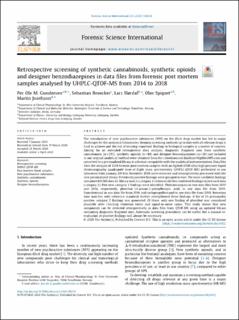| dc.contributor.author | Gundersen, Per Ole Mobråten | |
| dc.contributor.author | Broecker, Sebastian | |
| dc.contributor.author | Slørdal, Lars | |
| dc.contributor.author | Spigset, Olav | |
| dc.contributor.author | Josefsson, Martin | |
| dc.date.accessioned | 2021-03-19T13:11:51Z | |
| dc.date.available | 2021-03-19T13:11:51Z | |
| dc.date.created | 2021-01-18T10:54:20Z | |
| dc.date.issued | 2020 | |
| dc.identifier.issn | 0379-0738 | |
| dc.identifier.uri | https://hdl.handle.net/11250/2734512 | |
| dc.description.abstract | The introduction of new psychoactive substances (NPS) on the illicit drug market has led to major challenges for the analytical laboratories. Keeping screening methods up to date with all relevant drugs is hard to achieve and the risk of missing important findings in biological samples is a matter of concern. Aiming for an extended retrospective data analysis, diagnostic fragment ions from synthetic cannabinoids (n = 251), synthetic opioids (n = 88) and designer benzodiazepines (n = 26) not included in our original analytical method were obtained from the crowdsourced database HighResNPS.com and converted to a personalized library in a format compatible with the analytical instrumentation. Data files from the analysis of 1314 forensic post mortem samples with an Agilent 6540 ultra high pressure liquid chromatography quadrupole time-of-flight mass spectrometry (UHPLC-QTOF-MS) performed in our laboratory from January 2014 to December 2018 were retrieved and retrospectively processed with the new personalized library. Potentially positive findings were grouped in two: The most confident findings contained MS/MS data for library match (category 1) whereas the less confident findings lacked such data (category 2). Five new category 1 findings were identified: Flubromazepam in two data files from 2015 and 2016, respectively, phenibut (4-amino-3-phenylbutyric acid) in one data file from 2015, fluorofentanyl in one data file from 2016 and cyclopropylfentanyl in one data file from 2018. Retention time matches with reference standards further strengthened these findings. A list of 35 presumably positive category 2 findings was generated. Of these, only one finding of phenibut was considered plausible after checking retention times and signal-to-noise ratios. This study shows that new compounds can be detected retrospectively in data files from QTOF-MS using an updated library containing diagnostic fragment ions. Automatic screening procedures can be useful, but a manual re-evaluation of positive findings will always be necessary. | en_US |
| dc.language.iso | eng | en_US |
| dc.publisher | Elsevier | en_US |
| dc.relation.uri | http://liu.diva-portal.org/smash/get/diva2:1451407/FULLTEXT01.pdf | |
| dc.rights | Navngivelse 4.0 Internasjonal | * |
| dc.rights.uri | http://creativecommons.org/licenses/by/4.0/deed.no | * |
| dc.title | Retrospective screening of synthetic cannabinoids, synthetic opioids and designer benzodiazepines in data files from forensic post mortem samples analyzed by UHLC-QTOF-MS from 2014 to 2018 | en_US |
| dc.type | Peer reviewed | en_US |
| dc.type | Journal article | en_US |
| dc.description.version | publishedVersion | en_US |
| dc.source.volume | 311 | en_US |
| dc.source.journal | Forensic Science International | en_US |
| dc.identifier.doi | 10.1016/j.forsciint.2020.110274 | |
| dc.identifier.cristin | 1872988 | |
| dc.description.localcode | 0379-0738/© 2020 The Author(s). Published by Elsevier B.V. This is an open access article under the CC BY license (http://creativecommons.org/licenses/by/4.0/). | en_US |
| cristin.ispublished | true | |
| cristin.fulltext | original | |
| cristin.qualitycode | 1 | |

